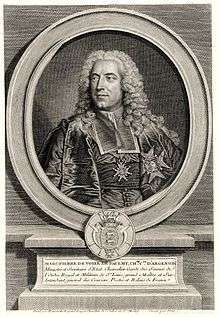Marc-Pierre de Voyer de Paulmy d'Argenson


Marc-Pierre de Voyer de Paulmy, Comte d'Argenson (16 August 1696, Paris – 22 August 1764, Paris) was a French politician
Biography
D'Argenson, a younger son of Marc-René de Voyer de Paulmy d'Argenson (1652–1721), was born on 16 of August 1696. Following the family tradition he studied law and was councillor at the parlement of Paris. He succeeded his father as lieutenant-general of police in Paris, but held the post only five months (January 26 to June 30, 1720). He then received the office of intendant of Tours, and resumed the lieutenancy of police in 1722.[1]
On 2 January 1724 d'Argenson was appointed councillor of state. He gained the confidence of the regent Philippe, Duke of Orleans, administering his fortune and living with his son until 1737. During this period he opened his salon to the philosophers Chaulieu, the Marquis of la Fare and Voltaire, and collaborated in the legislative labours of the chancellor d'Aguesseau.[1]
In March 1737 d'Argenson was appointed director of the censorship of books, in which post he showed sufficiently liberal views to gain the approval of writers—a rare thing in the reign of Louis XV. He only retained this post for a year. He became president of the grand council (November 1738), intendant of the généralité of Paris (August 1740), was admitted to the king's council (August 1742).[1]
In January 1743 d'Argenson was appointed secretary of state for war in succession to Baron de Breteuil. As minister for war he had a heavy task; the French armies engaged in the War of the Austrian Succession were disorganized, and the retreat from Prague had produced a disastrous effect. After consulting with Marshal Saxe, he began the reform of the new armies. To assist recruiting, he revived the old institution of local militias, which, however, did not come up to his expectation. In the spring of 1744 three armies were able to resume the offensive in the Netherlands, Germany and Italy, and in the following year France won the Battle of Fontenoy, at which d'Argenson was present.[1]
After the peace in 1748 d'Argenson occupied himself with the important work of recasting the French army on the model of the Prussian. He unified the types of cannon, grouped the grenadiers into separate regiments, and founded the École Militaire for the training of officers (1751). An edict of 1 November 1751 granted patents of nobility to all who had the rank of general officer. In addition to his duties as minister of war he had the supervision of the printing, postal administration and general administration of Paris. He was responsible for the arrangement of the promenade of the Champs Élysées and for the plan of the present Place de la Concorde. He was exceedingly popular, and, although the court favourites hated him, he had the support of the king. Nevertheless, after the attempt of Robert-François Damiens to assassinate King Louis XV, Louis abandoned d'Argenson to the machinations of the court favourites and dismissed both him and his colleague, the Comte d'Arnouville (February 1757).[1]
D'Argenson was exiled to his Château and estates at Les Ormes near Saumur, but he had previously found posts for his brother, René Louis, Marquis d'Argenson, as minister of foreign affairs, for his son Marc René as master of the horse, and for his nephew Marc Antoine René as commissary of war. From the time of his exile he lived in the society of savants and philosophers. He had been elected member of the Académie des Inscriptions in 1749. Diderot and d’Alembert dedicated the Encyclopédie to him, and Voltaire, Charles-Jean-François Hénault, and Jean-François Marmontel openly visited him in his exile. After the death of Madame de Pompadour he obtained permission to return to Paris, and died a few days after his return, on 22 August 1764.[1]
Notes
References
 This article incorporates text from a publication now in the public domain: Chisholm, Hugh, ed. (1911). "Argenson". Encyclopædia Britannica. 2 (11th ed.). Cambridge University Press. pp. 457–460.
This article incorporates text from a publication now in the public domain: Chisholm, Hugh, ed. (1911). "Argenson". Encyclopædia Britannica. 2 (11th ed.). Cambridge University Press. pp. 457–460.
| Political offices | ||
|---|---|---|
| Preceded by François Victor le Tonnelier de Breteuil |
Secretary of State for War 1743–1757 |
Succeeded by Marc-René de Voyer, marquis de Paulmy |